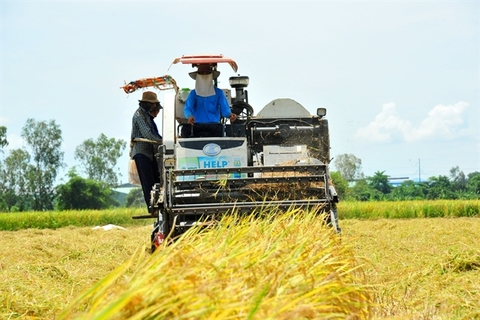Viet Nam is contributing to ensuring food security not only for its own people but also for the wider region and the world, according to Deputy Minister of Agriculture and Rural Development Phung Duc Tien.
The agriculture deputy minister made this statement at a press conference this week in Ha Noi, acknowledging the agricultural sector as the "firm foundation" of the national economy.
The Ministry of Agriculture and Rural Development (MARD) held the press conference to release official information about the country's agricultural production and exports in the first six months of the year.
Tien said the agricultural sector implemented a plan for the first six months of 2023 to address challenges, of which, the export market for agro-forestry-fishery products, mainly for wood and aquatic products, was a particular difficulty.
He said the country still has much potential in agricultural exports and MARD will undertake flexible solutions to boost management, adapting to the new context and meeting the demands of the world market.
While ASEAN countries and the agriculture industry around the world is currently concerned about food security, Viet Nam has achieved impressive results in ensuring food security for its 100 million population while maintaining its standing in the global rice export market.
"People often believe that over time, rice yield will decrease, but this year the situation did not happen because the MARD has learned from previous experience and promptly provided technical support for farmers," said the agriculture deputy minister.
Nguyen Nhu Cuong, Director of the MARD's Department of Crop Production identified current development trends, especially the migration of the workforce to urban environments, industrialisation and exploration in different crops, as causing negative impacts on rice production.
However, with the application of scientific and technological advances in seed and seedling cultivation, along with a timely respond to climate change, the country's agricultural sector is fully operational over the next six months of the year and in the next two years, ensuring both exports and domestic consumption.

Viet Nam is also focusing on exporting high-quality, good-priced rice. — Illustration photo nongnghiep.vn
A report from MARD shows rice and other crop production in the first six months of the year achieved good results.
The whole country planted about 4.98 million ha of rice with an average yield of 67 quintals/ha, an increase of 1.8 quintals/ha, with output reaching 22.8 million tonnes.
Rice exports in the first six months reached 4.2 million tonnes, earning $2.32 billion, including $300 million in June. The average export price of rice in the first five months of 2023 was estimated at $517 per tonne, up 5.8 per cent over the same period in 2022.
Meanwhile, VNDirect expects the export price of rice to continue to increase in 2023 thanks to the increased demand for food reserves in many countries, and Viet Nam is also focusing on exporting high-quality, good-priced rice.
According to data from the General Department of Customs, in 2022, Viet Nam's rice exports were recovering from the impact of the COVID-19 pandemic, totalling 7.1 million tonnes, equivalent to $3.5 billion.
In the agricultural sector report, VNDirect said that rice demand will remain high in 2023 as political and economic uncertainties push up the demand for rice reserves. Besides this, climate change is still affecting rice supply in many countries, especially the Philippines, due to floods, and China, due to drought.
Analysts also expect rice export prices to continue to increase in 2023 thanks to increased demand for food reserves in many countries.
Viet Nam is focusing on producing high-quality rice to match global consumption trends since many rice-growing areas have switched to other more profitable crops.
MARD reported the area of agricultural land used for the 2022-2023 crop year in the country has decreased by 3 per cent compared to the previous crop.
Cuong said although Viet Nam's cultivation area is not large but agricultural export value is not inferior to that of many other countries, with its agricultural products present in all countries and territories in the world.
In the first half of 2023, fruit and vegetable export turnover was estimated at $2.8 billion, including $950 million in June, up 2.6 times compared to June 2022.
The fruit growing area was about 1.22 million ha, up 2.7 per cent with an increase in output of many items such as mango, oranges, rambutan and lychee while the area used for industrial crops expanded to 2.2 million ha, up 0.3 per cent with output raising in pepper, rubber, cashew, and tea cultivation.
"The target to reach US$10 billion from exports of vegetables and fruits can be fulfilled in the future despite a downtrend in the area due to industrialisation, urbanisation and other factors," he said.
Tien emphasised that fruit and vegetable exports have never been as high as they are now. "According to this growth momentum, it is certain that in 2023, the country's fruit and vegetable exports will reach over US$5 billion and if investment is more focussed on deep processing and market expansion, the figure of US$10 billion from will likely be achieved," he said. — VNS